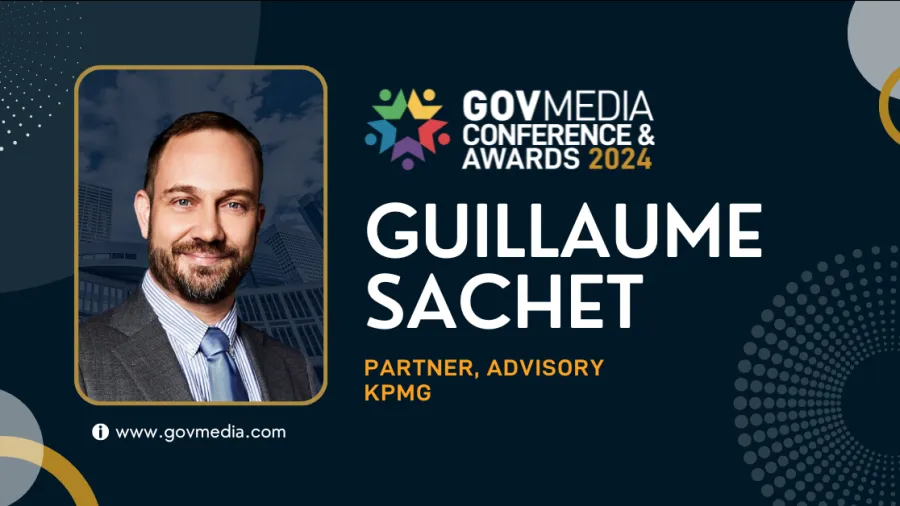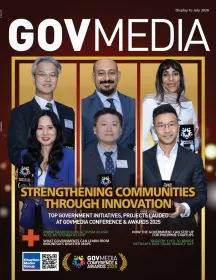
Fostering innovation in government requires shift in mindset, engagement beyond core groups – Guillaume Sachet of KPMG in Singapore
Sachet's observations offer a roadmap for governments seeking to harness the power of digitalisation to drive meaningful societal change.
In the era of digital innovation, governments face the complexity of integrating technology into their frameworks to enhance service delivery, drive efficiency, and stimulate economic growth.
With over 27 years of experience, Guillaume Sachet, an advisory partner at KPMG in Singapore, is well-versed in digital transformation and how these trends can be a driving force in reshaping the government sector. His experience in Singapore and across the region has been instrumental in spearheading customer-centric strategies across a wide range of industries and sectors.
As a judge in the GovMedia Conference & Awards 2024, he shares his insights on how the government can navigate the nuances of digital transformation within public sector frameworks, including how to identify risks and opportunities, especially with the intersection of technology, innovation, and public policy.
Could you elaborate on the strategies you've found most effective in aligning digital transformation initiatives with broader government objectives, such as improving service delivery, increasing efficiency, and fostering economic growth?
The rapid adoption of digital technologies has played a large role in revolutionising many areas of the economy. The government sector is not spared from this change and is, in fact, one of the largest stakeholders in this ecosystem of change. With its role in spearheading digital transformation at a national level, the government sector is expected to lead the change when it comes to integrating technologies in the public sector.
One way to approach digital transformation is from an outcomes-driven perspective, especially given the large-scale transition and long runway that these transformation roadmaps often require. Instead of doing a stock take on whether objectives have been achieved at the end of the project, it would be useful to embed these goals into every step of the process. For example, some key demands that the public sector faces include having to be citizen-centric as well as securing and maintaining digital trust when it comes to introducing new technologies into public services. Thus, these digital transformation initiatives should be structured around these objectives to ensure that the transition is successful.
Increasingly, we observe that there has been a growing desire from citizens and communities for the public sector to become more accessible and approachable, with citizens expecting the same level of support that they receive from other industry sectors. This is an area that the Government can consider when it comes to how it can plan for its digital transformation roadmaps to meet such needs. Using technology to bridge the gap between the Government and its citizens through user-friendly services is one solution that authorities can consider.
Lastly, when it comes to digital transformation, another key consideration for the sector is the need to maintain a strong level of digital trust. A digital transformation journey need not always be one that requires an overhaul of IT processes and systems. Instead, it can also strengthen peripheral support to prime the sector for emerging changes, such as ensuring that civil servants have a high level of digital literacy. This will not only help the sector gear itself for a more digitally savvy future but also serve as a magnet to attract the best talent to bring digital transformation plans to life.
What are some common pitfalls or misconceptions you've observed governments encountering when embarking on large-scale digital transformation projects, and how can they be mitigated?
Given the sheer scale of digital transformation projects, it would not be reasonable to expect a smooth transition from the get-go. However, it is possible to re-think certain approaches to digital transformation to increase the success of desired outcomes.
Interestingly, one pitfall when rolling out such projects may not be the strength of the ideas themselves, but a mismatched implementation plan. Traditionally, the public sector often falls back to traditional methods of execution, for example, in instances when they face a conundrum between agile and waterfall delivery. To sum it up, the waterfall delivery method is an implementation roadmap where sequential tasks are dependent on the previous task for the project to move along. Meanwhile, agile delivery means that the projects are broken down into smaller chunks, where each segment is worked on and developed in tandem.
Large organisations, such as the government sector, tend to adopt the waterfall method. However, the dynamic nature of innovation and transformation means that change will need to be expected and that a flexible method of implementation is required to ensure that progress is not hindered by any aspect of the project that does not go exactly as planned. Ultimately, the takeaway is that workflows should be constantly relooked and customised to the nature of the project.
The public sector also often faces a dilemma between adopting a commercial mindset or one that is centred around public service. In such situations, it is useful for the public sector to look at the project from a commercial approach, whilst retaining its focus on the greater good of citizens. Governments can navigate this dilemma effectively by ensuring that transparency, accountability, and inclusivity are prioritised in all digital transformation efforts.
Could you highlight some key insights or trends you've identified in the evolving relationship between technology, innovation, and public policy, particularly within the context of government modernisation efforts?
Unlike the past, where the public sector was often viewed as archaic, the rapid advancement of digitalisation has resulted in increasing integration between technology, innovation, and public policy. Many government officials are now exploring ways to become more digitally savvy and maintain a strong online presence. This is in response to the fact that many citizens and businesses are now more open to digitalised public services, changing the way public policies are designed and delivered.
This redefined relationship means that technologies, such as the advent of Web 3.0 have the potential to change the way the public sector interacts with its constituents. Web 3.0, artificial intelligence, and the metaverse have created virtual spaces where citizens can interact with government, healthcare professionals, private companies, and communities. It also means that these virtual spaces may soon become the preferred channel of engagement for citizens and governments.
In addition, we already see many instances of how data is being used to guide and predict the needs of citizens. Much of the work in the public sector requires significant foresight and planning to prime the country for future challenges and opportunities. Data analytics is a powerful tool in helping the sector enhance its decision-making processes, as well as to anticipate future trends and opportunities. Insights gleaned from this data can then be used to tailor upcoming and current policies or services to better meet the needs of citizens.
How do you think the intersection of media and technology is influencing traditional approaches to governance and public engagement, and what opportunities does this present for driving meaningful societal change?
The points mentioned earlier all point to the symbiotic relationship between technology and the public sector having the potential to result in synergies that can revolutionise the way public services are delivered. If leveraged well, it also presents many opportunities for the Government to tap into to engage its citizens and strengthen the relationship between both parties.
The intersection of media and technology has also opened up new ways of public engagement. Instead of viewing it as a challenge, the Government should view it as an opportunity to have more direct access to and interaction with the people they serve. It is not uncommon to see government officials taking to social media to reach a wider audience and relate to younger age groups.
However, with technology, one challenge that the Government is facing is the growing risk of misinformation, leading to a growing need for verification and accountability. This need for credibility provides many avenues for the Government to think of ways to strengthen the relationship between the public sector and the people. Concerns around misinformation also pave the way for the Government to consider a more fact-based and transparent mode of communication to maintain and deepen the trust that is crucial for an effective government.
What strategies do you advocate for governments seeking to foster a culture of innovation and entrepreneurship within their jurisdictions, and how can they create an enabling environment that encourages experimentation, risk-taking, and knowledge-sharing?
Before embarking on any sort of transition, be it digital or non-digital, it is important to ensure that the organisation is fit for such a change. Fostering a culture of innovation in the government sector goes beyond just looking at technological aspects and technical processes but also developing and shaping an innovative mindset.
One way to tackle this is to ensure that the affected stakeholders are rightfully engaged when it comes to developing solutions for business problems. For the government sector, this goes beyond the “core group,” which is the people it serves. Instead, the surrounding ecosystem, such as non-profit groups, the business community, or even regional counterparts, should also be consulted. There are already some efforts kickstarted by the public sector to engage the citizenry in co-creating digital solutions, such as through collaborations or ground-up activities.
Given your role as a judge at the GovMedia Awards 2024, what specific qualities or outcomes do you believe distinguish truly outstanding government projects?
With the amount of authority and influence it has, the government sector is crucial in shaping the growth and direction of the country and region. Impactful government projects will not only affect the present but also change the future of generations down the road.
As such, it is imperative for the public sector to be closely in tune with the needs of its citizens. With the rapid growth of digitalisation, the winning entries this year will be the ones that display a judicious use of technology to spur innovative ways on how the sector can go above and beyond to serve the needs of its citizens.













